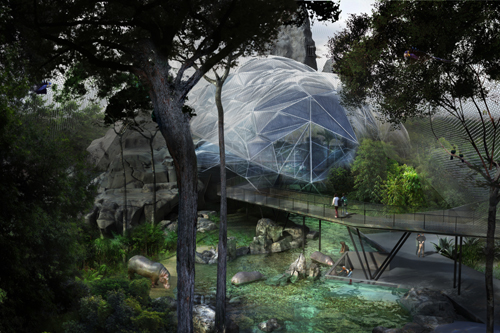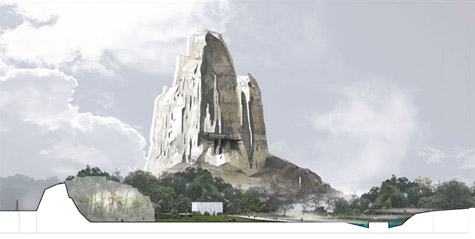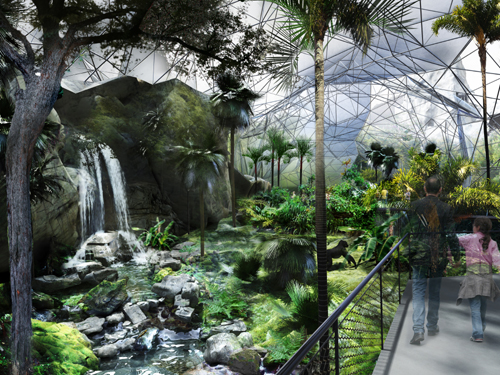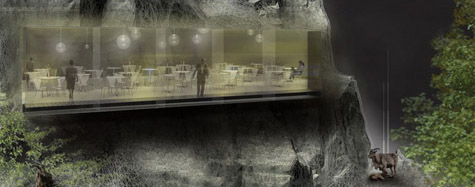Simulated Environments for Animals
 [Image: The Zoo de Vincennes, by Beckmann N'Thepe].
[Image: The Zoo de Vincennes, by Beckmann N'Thepe].These are some plans for a new zoological park in Vincennes, France. The zoo's landscapes are designed by TN PLUS Landscape Architects, its buildings by Paris architects Beckmann N'Thepe.
The project is noteworthy for, among other things, what could be called its simulated geology.
 [Image: Landscapes in the Zoo de Vincennes, designed by TN PLUS Landscape Architects].
[Image: Landscapes in the Zoo de Vincennes, designed by TN PLUS Landscape Architects].These artificial earthforms will contain simulated environments within which animals will live. The whole complex will encompass 15 hectares and six "biozones," and it will run partly on solar power.
 [Image: The Zoo de Vincennes, by Beckmann N'Thepe].
[Image: The Zoo de Vincennes, by Beckmann N'Thepe].The park's "biozones" include the savannah, the equatorial African rain forest, Patagonia, French Guiana, Madagascar, and Europe.
 [Image: More landscapes in the Zoo de Vincennes, by TN PLUS Landscape Architects].
[Image: More landscapes in the Zoo de Vincennes, by TN PLUS Landscape Architects].So the zoo – like all zoos, of course – will be a simulation intended for animals. Zoos, in other words, are a particularly bizarre form of trans-species communication, attempted on the level of architecture and landscape design.
They're like hieroglyphs that animals inhabit – spaces defined entirely by their ability to refer to something they are not.
 [Images: Zooscapes by TN PLUS Landscape Architects].
[Images: Zooscapes by TN PLUS Landscape Architects].More information, if you read French, is available in this PDF.
 [Image: The Zoo de Vincennes, by Beckmann N'Thepe].
[Image: The Zoo de Vincennes, by Beckmann N'Thepe].And I have to say that the renderings of this place look pretty cool.
But why do we only build zoos like this? Why not suburbs or college campuses? You mold landforms out of reinforced concrete, and you install artificial waterfalls and fake rivers, and you grow rare orchids under the cover of geodesic domes. And then your grandkids can grow up in a savannah-themed suburb outside Orlando. The next town over, kids run around through giant fern trees, chasing parrots.
Perhaps themed biozones are the future of suburban design?
 [Image: The Zoo de Vincennes, by Beckmann N'Thepe].
[Image: The Zoo de Vincennes, by Beckmann N'Thepe].Google opens a new administrative complex outside London – on the grounds of a former zoo. Your "cubicle" is partly outside.
Hidden nozzles mist your neck on every lunch break.
 [Image: The Zoo de Vincennes, by Beckmann N'Thepe].
[Image: The Zoo de Vincennes, by Beckmann N'Thepe].(Zoo de Vincennes discovered by Architectural Record).





Comments are moderated.
If it's not spam, it will appear here shortly!
But why do we only build zoos like this? Why not suburbs or college campuses?
Cost. While I would love it if people did this is the "real world", its just plain to expensive to do, and ramps the upkeep sky high.
Some precedents.
Pulhamite: a mortar or terracotta made to resemble 'natural' rock. A dedicated website here. English Heritage have just published a history of the James Pulham & Son firm called 'Durability Guaranteed'.
West 8: the Rotterdam firm produced a peculiar entry for the UK's Architecture Foundation competition called Living in the City (2000). Model photo here
i think we should figure out how to build sustainable suburbs before we build disney-like, high maintenance and expensive fake ones
Instead of "build sustainable suburbs", shouldn't that read "make existing suburbs sustainable"? Do you want more suburbs? Do you want to encroach further and further out?
And why can't these zoo-suburbs be sustainable, whatever that is? With a little bit of imagination, one could easily picture these simulated geology creating microclimates, helping to mitigate northern cold winds and southwesternly sun by acting as barriers and shades. Simulate termite mounds and you could have your own artificial temperature regulation system. And constructed wetlands could help with stormwater management.
High maintenance? Sure. But you could do well by tending to the garden instead of sitting in front of your tv or going to the mall or spending all your days blogging.
This isn't technically a zoo, but the design is totally awesome
Not long ago the Japanese central glass organized a contest with the theme "zoo natural" it is interesting to see the winning proposals on the website of the central co glass.
Here my proposal http://www.a-minimal.com/zoo.htm
There is a appartment building in Montreal right next to Habitat 67 that has a huge atrium for the enjoyment of the residents- I think it is called tropiques de Nord.
Residents have balconies that open up onto the tropical atrium.
We also have a biodome in montreal- the old olympic velodrome converted to various natural environments.
Wouldn't these translucent structures grow on site from crystalline seeds set in a smart membrane? So that instead of growing tree houses, urban cave-bubbles spread like foam across the existing urban landscape? As with the Eden Project, former quarries and mines could provide the landscape setting. While gardens (plant, zoological or otherwise) might be the first to get built, colleges, business parks and other sorts of campus would be suitable candidates.
Wouldn't these translucent structures grow on site from crystalline seeds set in a smart membrane?
Wha?
So this is what the designers think the animals want...
Trevi: sustainability wouldn't be enough to provide a truly "honest" -sorry can't think of a better word- habitat; this doesn't take into account other traits like migration, or the cyclical renovation of the alpha figure, or limits a group or individual could overcome in order to find a better environment (food, breeding grounds or the unthinkable: the end of interaction with Man).
No matter what we design, a zoo will always cather to visitors.
As someone looking to go back to college for a second degree and thus having no federal funding available to me, I'd be excited to see a college campus with a tropical environment encased in the snowy slush of wintry downtown Boston, but I can't even imagine how much more tuition would cost!
Though it would be pretty sweet to look out over lush gardens while I practice piano. Maybe we could argue that it provides creative inspiration. Ha!
"Zoom in on my empty wallet." - Rent, the musical.
The zoo of the parallel zones is described like a human route drawn up Ander a natural area of abundant wild life. The human layout is a underground movement area, a long- haul that it illuminates to the people in different collective or personal stations, where whit passive Technologies Developer by the intellect the human appears this in the animal habitat dont be seen, obtaining the observation of the animal species in its natural state, is the discovery of the secret activities of the animals.
"Simulated"
"reproduction"
"cultured stone"
Can we please stop building FAKE things. Was no one taught about honesty in materials?
Just because something is as massive as this zoo does not mean it will be any more authentic. Just like disneyland it will read as phony to people visiting.
Besides, didn't we learn anything from the massive failure of Eurodisney? Europeans have extremely sophisticated taste and generally see right through this kind of garbage.
Sure its a massive undertaking, but up close a fake rock still looks and feels like a fake rock. Its these "fake" experiences that are degrading people's quality of life.
Well, a zoo is a fake experience anyway, and some of them are necessary to protect endangered animals (complain about capitalism destroying the planet, not zoos protecting endangered species). So the environments for the animals should be as close to real as possible, their fakeness being a given.
In terms of environments like this for people, why not use real materials, and just arrange them in an aesthetically pleasing themed design? Right now we have a strange aesthetic for the human living quarters: mini-mansions in sprawling, environmentally razed suburbs. Themed biozones could be an interesting part of a more sustainable community plan, and in terms of cost, look at where your tax dollars are going now: the latest Department of Defense offensive and subsidies for coal and oil.
They're like hieroglyphs that animals inhabit – spaces defined entirely by their ability to refer to something they are not...
...But why do we only build zoos like this? Why not suburbs or college campuses? You mold landforms out of reinforced concrete, and you install artificial waterfalls and fake rivers...
Um, we do.
How else do you explain the plantation house on a green lawn in Phoenix?
What about Reston, VA, where residents bask in the created beauty of man-made lakes.
Examples abound.
Or is the real question, "why don't we call suburbs 'human biodromes'?"
Oh yeah, I forgat the Pearl River Delta. The whole thing, at this point!
That was funny. Someone needs to start misting my neck at lunchtime. Also, I would like to have a tire swing and sawdust in my cubicle.
translation of the pdf
Particular aspects and materials: Technique of the standard concrete "false rocks". Greenhouses out of membrane ETFE screen printed like continuity (dematerialization) of the rocks - specific work with the artist Susanna Fritscher. Step HQE (photovoltaic panels).
TEXT: "Marked by the emotive heritage of a shared culture, the architecture of the new Zoo of Vincennes is given to see in a developed geography, moved away from one time when architecture continued and anchored itself in a formalism and a reducing temporality. An invitation for the visitors with the discovery, between science and leisures, in order to build future memories there... The emblematic identity of the "false rocks" of the Zoological gardens is thus reinforced, and dictates its rules for the installation of its future program. In the logical continuation, the greenhouses develop like a continuity by a soft and natural intervention: they find their modeling by a coarse pixellisation of the rocks and marry their irregular forms. The new tandem Rock/Serre allows the establishment of last technologies and research on High Environmental Quality. Here a landscape invented between form and informs, absolutely modern, i.e. nine and artificial, which marries the silhouette familiar of the six landscapes (biozones) suggested. It seizes their natural materials, rocks and granitic stones, trees, shrubs, foams and lichens in an imitation pretends since mix with it with the interventions with materials of human industry, glass and metal, in frank inclusions and out of scale which cap the rocks of various functions. This new identity relief wants to be intriguing, mysterious and gravitational to be able to become the icon of the new life of the Zoological gardens "
To critics of the fakes: These enormous concrete mountains are already there on the site of the old zoo and I bleieve they are protected. So rather than disneyfiying the zoo expereince, they are simply making the best of what they have and he restrictions this involves
Cool page you have. Looking forward to read more entries.
Cheers
TheJunction
Like Paco Argenti, I also want a tire swing and sawdust in my cube. Let's do it.
Here's a side effect to consider: all the manmade environments mimic those parts of nature that resemble some sort of paradise (waterfalls around every corner, giant ferns with parrots). Does this create an expectation amongst the next generation that nature must be spectacular to be appreciated?
Good Lord ! Themed biozoned suburbs?! you've got to be kidding me. That would be like putting make-up on a mannequin. How about a cluster of cookie-cutter savannas sprawled around a lifestyle center based on a tropical rainforest theme outside of Surprise, AZ ?
How about directing a fraction of the resources that are need for 'simulations' in conserving the real ecosystems that are fast disappearing?
Good idea,
but this is not enough for this project
every zones need specific soils, suns, winds, waterings, STONES, geology ...
good idea but you need work more with science.
Post a Comment